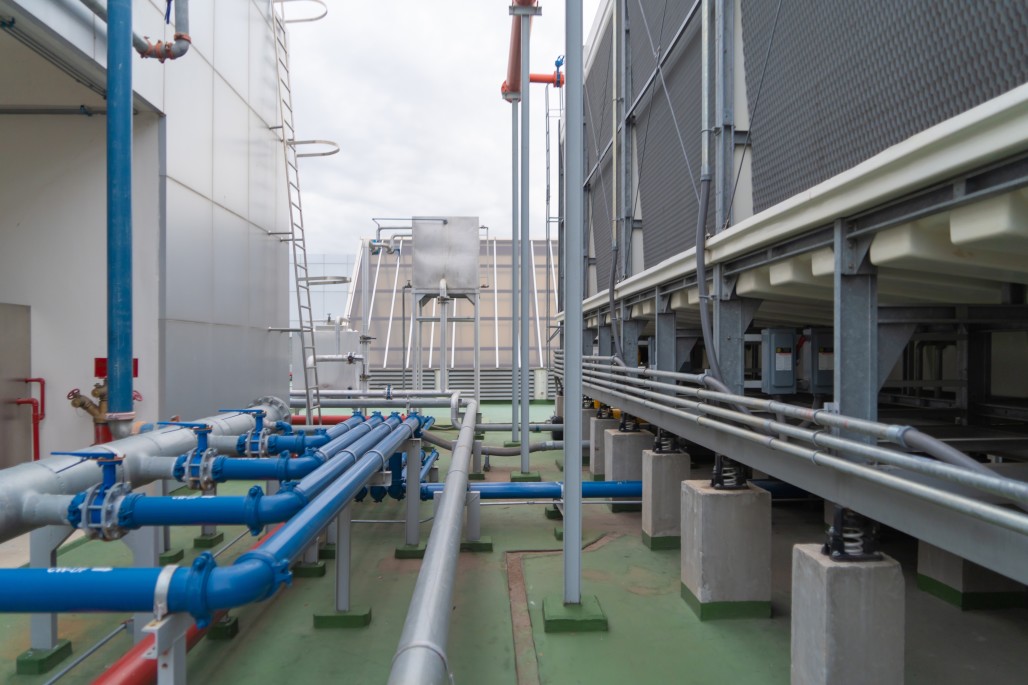The Cooling Tower Life Cycle

Cooling towers are complex units containing many components that each contribute to the sophisticated cooling process. Like all manufacturing processes, ideation to operation doesn’t happen instantly. Once a cooling tower design is complete, there are several stages to follow in the cooling tower life cycle.
Design
Cooling towers come in nearly any size and have multiple configurations. From different flow patterns to draft options to material types, many decisions come with the design process. Some applications allow for standard tower configurations, meaning no customization is needed, and manufacturers build the unit from a pre-set plan.
Others, especially those to be used in larger industrial applications, require a custom design to fit the unique specifications of the application location. From this initial design phase, the cooling tower life cycle moves into sourcing materials and manufacturing the unit.
Raw Material Sourcing
The first step, like in most manufacturing processes, is the sourcing of raw materials from which each component of a cooling tower is crafted. Because of the vast array of cooling tower configurations and material compositions, the term raw materials refers to quite a few different sources. For those towers and tower pieces that are made of metal, several options are available. Steel, aluminum, nickel, and brass are all top-quality options.
Manufacturers still build some towers from wood, with redwood being a popular choice as it resists decay over time and is widely available (making it also affordable). One tower part which used to consistently be crafted from wood is the tower’s fill. A “fill” refers to the medium inside cooling towers that acts as an additional surface area for water to spread across as it travels. Rather than continue to build fills from wood, many manufacturers now source PVC for that. PVC allows more effective heat transfer during the cooling process, making it more efficient than wood alternatives.
Manufacturing
During the manufacturing portion of a cooling tower’s life cycle, individual tower components are crafted from raw materials, and then those components are used to construct the tower itself. Tower components include its body, the fill media, electric motors, and pumps. The manufacturing process can take some time, especially for larger industrial cooling towers. Manufacturers build units in one of two ways.
Factory-Built Packaged Towers
For smaller applications, most choose this type of tower as it is much less expensive than the alternative. Factory-built units are constructed at a manufacturing facility and arrive on-site to be installed. Because they are built to the same specifications each time, there is no customization allowed when choosing this type of unit.
Field Erected Cooling Towers
When customization is needed, field-erected cooling towers may be a better option. Many components comprise these units, and each part is brought on-site to be combined and installed. Because of this, buyers have some control over the parts and materials that arrive from the manufacturer. Field erected towers are also designed to handle a higher heat rejection load than factory-built alternatives. So, for large applications like refineries and power plants, they are the preferred choice.
Installation & Operation
Once construction finishes, a unit is placed and installed on site. At this point – or from the first cooling cycle – a tower enters the longest stage of its life cycle – operation. Modern cooling towers last far longer than their predecessors. The American Society of Heating, Refrigerating and Air-Conditioning Engineers (ASHRAE) determines that cooling towers now last between 20-34 years when properly maintained.
End-Of-Life
Throughout a cooling tower’s lifespan, issues undoubtedly arise that require repair. In many cases, minor repairs or replacing individual components of the unit solves the problem. However, when the repairs become more costly, it may begin to make financial sense to install a new tower rather than continue to make the repairs. At that point, a cooling tower ends its life cycle and is deconstructed and removed from the site.
Ensuring a Long Cooling Tower Life Cycle
How long a tower lasts highly depends on whether it was well operated and maintained throughout its life. Proper training of all tower operators ensures minimal mistakes or issues caused by negligence or untrained staff. In addition to training, tower owners must implement a preventative maintenance plan. Regularly inspecting and repairing minor problems that arise often prevents escalation of these down the road.
Not all owners have a team onboard knowledgeable and trained well enough to perform preventative maintenance on cooling towers. In these cases, bringing in experts in the field to handle the tower’s maintenance is a great alternative. To an untrained eye, minor tower issues often go unnoticed. This can lead to the issue escalating and potentially to unit failure or a down HVAC system entirely. So, having the experts onboard limits the potential losses, both financially and in time spent waiting for system recovery in these cases.
At Cooling Tower Experts, we pride ourselves on being there for whichever part of the cooling tower life cycle you need us. From our consultation services to our preventative maintenance plans – we can help ensure you choose the right tower for your application and have one that will continue to run efficiently for many years after installation. Whatever your project, Cooling Tower Experts is happy to help. Contact us today to begin your cooling tower project!